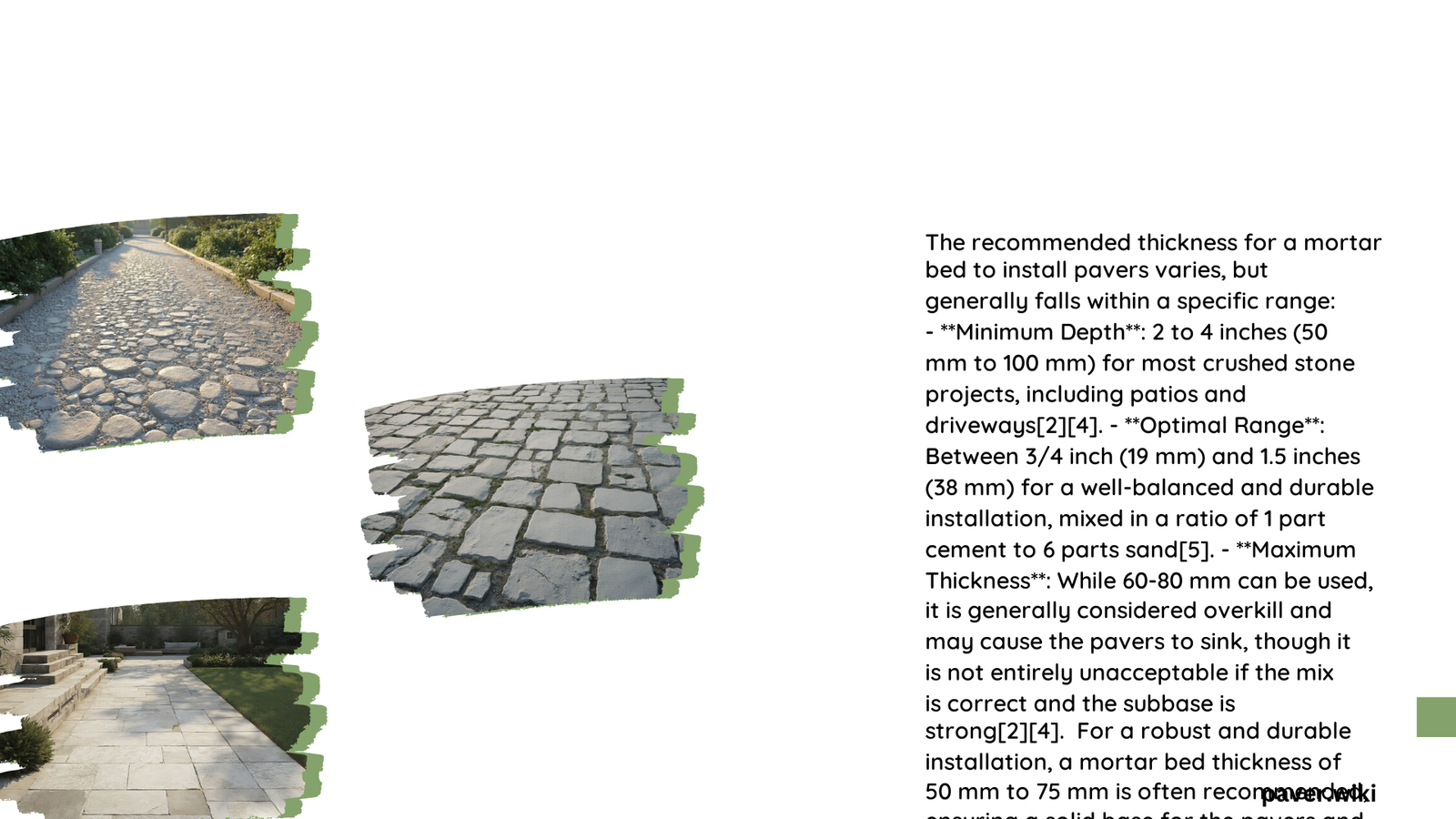The thickness of the mortar bed for installing pavers is crucial for ensuring stability, durability, and longevity of your paved surface. Generally, the recommended thickness ranges from 1.25 inches (32 mm) for residential applications to 3.5 inches (88 mm) for heavy vehicular traffic areas. Factors such as traffic load, subbase quality, and environmental conditions influence the ideal mortar bed depth. This guide will explore the optimal mortar bed thickness for various paver installations and provide insights on proper installation techniques.
What is the Ideal Mortar Bed Thickness for Different Paver Applications?
The ideal mortar bed thickness varies depending on the specific application and expected load:
- Residential and Light Traffic Areas:
- Recommended thickness: 1.25 inches (32 mm)
-
Suitable for patios, walkways, and light-use driveways
-
Heavy Vehicular Traffic Areas:
- Recommended thickness: 2 to 3.5 inches (51 to 88 mm)
-
Ideal for commercial driveways and high-traffic zones
-
Patio and Driveway Applications:
- Recommended thickness: 30-50 mm (1.2-2 inches)
-
Can be increased to 60-80 mm (2.4-3.2 inches) for stronger subbases
-
Countertops and Shower Receptors:
- Recommended thickness: 3/4 to 1.5 inches (19 to 38 mm)
- Specific requirements may apply as per ANSI A108.1A-2.3
What Factors Influence the Required Mortar Bed Thickness?

Several factors play a role in determining the appropriate mortar bed thickness:
- Subbase Quality:
- A strong, well-compacted subbase allows for a thinner mortar bed
-
Weak or unstable subbases may require thicker mortar beds for added strength
-
Traffic Load:
- Higher traffic areas need thicker mortar beds to withstand increased stress
-
Pedestrian areas can typically use thinner mortar beds
-
Environmental Conditions:
- Freeze-thaw cycles may necessitate thicker beds or additional reinforcement
-
Areas with high rainfall might require thicker beds for improved drainage
-
Paver Size and Weight:
- Larger or heavier pavers may require a thicker mortar bed for proper support
- Smaller pavers can often be installed with thinner mortar beds
How to Ensure Proper Mortar Bed Depth During Installation?
Achieving the correct mortar bed depth is crucial for a successful paver installation. Here are some techniques to ensure accuracy:
- Use Screed Rails:
- Install temporary screed rails at the desired mortar bed depth
-
Use a straight edge to level the mortar between the rails
-
Employ a Laser Level:
- Use a laser level to establish consistent height references across the installation area
-
Regularly check the mortar bed depth against these references
-
Create Test Areas:
- Install small test sections to verify the mortar bed depth before full-scale installation
-
Adjust techniques as needed based on test results
-
Use Proper Tools:
- Utilize notched trowels designed for the specific mortar bed depth
- Employ a rubber mallet to ensure pavers are set at the correct height
What Are the Challenges in Achieving the Correct Mortar Bed Depth?
Several challenges can arise when trying to maintain the proper mortar bed thickness:
- Uneven Subbase:
- An uneven subbase can lead to inconsistent mortar bed thickness
-
Solution: Properly grade and compact the subbase before mortar application
-
Weather Conditions:
- Extreme temperatures can affect mortar consistency and workability
-
Solution: Adjust work schedules and protect freshly laid mortar from adverse weather
-
Time Constraints:
- Rushing the installation process can lead to inconsistent mortar bed depths
-
Solution: Plan adequate time for proper installation and curing
-
Material Variations:
- Inconsistencies in mortar mix can affect bed thickness
- Solution: Use pre-mixed mortars or carefully measure ingredients for consistent results
How Does Mortar Bed Thickness Affect Cost and Material Quantities?
The thickness of the mortar bed directly impacts both cost and material requirements:
| Mortar Bed Thickness | Approximate Coverage (per 80 lb bag) | Relative Cost |
|---|---|---|
| 1 inch (25 mm) | 8 square feet (0.74 m²) | Low |
| 2 inches (50 mm) | 4 square feet (0.37 m²) | Medium |
| 3 inches (75 mm) | 2.67 square feet (0.25 m²) | High |
To calculate material needs:
1. Measure the total area to be paved
2. Determine the required mortar bed thickness
3. Use the coverage information to estimate the number of mortar bags needed
4. Add 10-15% extra for waste and uneven surfaces
Remember that while thicker mortar beds increase material costs, they may be necessary for certain applications to ensure long-term durability and performance.
What Are the Best Practices for Installing Pavers with the Correct Mortar Bed Thickness?
To ensure a successful paver installation with the proper mortar bed thickness, follow these best practices:
- Prepare the Subbase:
- Excavate to the required depth, accounting for the combined thickness of the subbase, mortar bed, and pavers
-
Compact the soil and add a layer of gravel or crushed stone for improved drainage
-
Install Edge Restraints:
- Use edge restraints to contain the pavers and prevent spreading
-
Ensure edge restraints are set at the correct height to accommodate the mortar bed and pavers
-
Mix Mortar Properly:
- Follow manufacturer’s instructions for mixing ratios
-
Ensure consistent mixing for uniform mortar bed thickness
-
Apply Mortar in Sections:
- Work in manageable sections to prevent premature drying
-
Use a notched trowel to create an even mortar bed
-
Set Pavers:
- Place pavers onto the mortar bed, tapping gently with a rubber mallet to ensure proper adhesion
-
Use spacers to maintain consistent gaps between pavers
-
Allow Proper Curing:
- Protect the newly installed pavers from foot traffic for at least 24 hours
- Allow the mortar to cure fully before applying any sealants or finishes
By following these guidelines and considering the specific requirements of your project, you can ensure that your paver installation has the correct mortar bed thickness for optimal performance and longevity.
